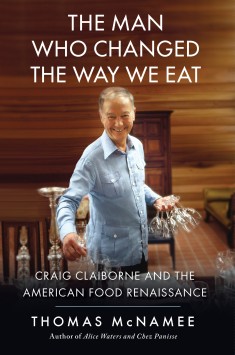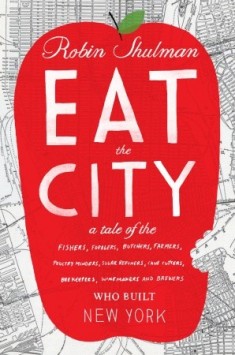New York a la CartRecipes and Stories from the Big Apple's Best Food Trucks
Some of the tastiest food in New York City can be found on the streets. The Big Apple has some of the best food trucks around. Collected in this book are recipes from some of the city’s most popular four wheeled food establishments.
Divided into neighborhood sections (Uptown, Midtown, Downtown, the Boroughs, etc.) New York a la Cart will spotlight the best of the Big Apple’s cart cuisine, profiling 50 vendors and including their most popular recipes. There are terrific “only in New York” stories here: the IBM exec who quit his six-figure job to flip Belgian waffles, the banquet hall chef who followed his dreams from Bangladesh to 46th Street, the second generation souvlaki masters carrying on their family traditions, among many others. With full-color photos that capture the local color as well as the delicious food, New York a la Cart is a celebration of the food-cart scene — but most importantly, offers more than 60 recipes so that readers can make their favorite street food at home.
Siobhan Wallace and Alexandra Penfold write the blog BlondieandBrownie, which has received almost 1 million visitors since its launch in 2009. Their stories and photos from the blog are regularly picked up by Serious Eats, Eater, and Grub Street. Siobhan and Alexandra also serve as editors for MidtownLunch, a website focused on finding the best lunches in NYC for under $10. They have appeared on the Cooking Channel’s Eat Street as food-truck experts, and (of course) live in New York City.
04/27/13: Book Court, Brooklyn, NY, 4 p.m.
05/17/13: Transit Museum midtown food truck/cart walking tour, New York, NY
05/21/13: WORD in Greenpoint section of Brooklyn, NY, 7 p.m.
06/14/13: Transit Museum midtown food truck/cart walking tour, New York, NY
Pondicherry Dosa
Dosas are a pancake dish made from fermented rice and lentils popular throughout south Asia. Thiru makes his on the spicy side with the addition of dried chiles and chili powder, but feel free to cut back on both if you can’t handle the heat. Soaking and blending the rice and lentils separately leads to a thinner batter—the consistency should end up similar to pancake batter. Thiru’s trick to spreading out the batter is to use a metal measuring cup to pour the batter onto your griddle or pan, and then use the bottom of the cup to spread it out in concentric circles, ultimately forming a paper thin circle. Due to the heat of the pan setting the batter, try to do the spreading within the first thirty seconds. Traditionally dosa are served with vegetable stew called sambar and coconut chutney. You can buy pre-made sambar and chutney at Indian specialty shops like Patel Grocery (see page 277).
Yield: Serves 6
1 cup uncooked rice (any type, according to your preference)
1 cup Urad Dal (lentils), split and shelled
Kosher salt
3 whole medium potatoes
2 carrots
2 large whole green lettuce leaves
2 bell peppers (mixture of red, green, yellow, orange), seeded
1 two ounce piece of ginger, peeled
2 tablespoons turmeric powder
2 medium onions (any type), finely chopped
1 tablespoon of olive oil
Indian spices:
1 tablespoon turmeric powder
2 teaspoons ajwain seeds
2 teaspoons mustard seeds
2 teaspoons chili powder
1 teaspoon black pepper
3 to 4 curry leaves
1 tablespoon fenugreek seeds
3 red dried chilies
Cooking spray
3 cups sambar, for serving
2 cups coconut chutney, for serving
Place the rice and lentils in separate large bowls and cover generously with water. Cover the bowls to encourage fermenting and soak the rice and lentils in water for at least 6 hours, until hydrated.
Drain the rice and lentils separately reserving their soaking liquid. Add the rice to a blender or food processor with approximately ¼ to ½ cup of the soaking water, blend until smooth, about a minute. Return the rice mixture to its bowl, then repeat with the lentils. Once the lentils are smooth combine the rice and lentils then blend together, adding salt to taste. As you’re blending, add additional soaking water in order produce a batter about the consistency of pancake batter—not too watery or too thick. Transfer the batter to a large bowl, cover and let it rest at room temperature or in a warm spot in your kitchen for at least 6 hours so that it can ferment naturally.
Meanwhile, to make the curry, peel and cut the potatoes into bite-sized pieces. Boil them until fork-tender. Roughly chop the carrots, lettuce, and peppers mixing them together, like you would for a salad, and set aside.
Sauté the onions with olive oil over low heat. Once the onions are translucent and tender, about three minutes, mix the Indian spices in with them and continue sautéing. Once the onions are fully coated and the spices have become aromatic, remove from heat and mix the cooled potatoes in to make the curry.
After the batter has finished fermenting—it will double in size and begin to give off a sour aroma—you are ready to make the dosa. Using a long-handled metal ladle, pour a ladleful of batter onto a heated grill or large non-stick pan prepared with cooking spray, trying to make circle. Working quickly use the back of your ladle to spread out the batter to create a large circle. Cook the dosa until the bottom is golden brown, and the top is dry. Once golden brown spots begin to appear on the top, add a heaping serving of the potato curry and put it on a plate. Serve with coconut chutney and sambar to dip the dosa in.
Adapted from Thiru Kumar’s recipe
Reprinted from NEW YOR A LA CART by Alexandra Penfold & Siobhan Wallace. Available from Running Press, an imprint of The Perseus Books Group. Copyright © 2013.
Photo: Clay Williams.












Leave a Reply